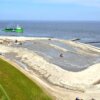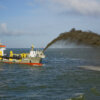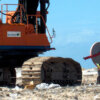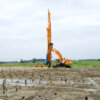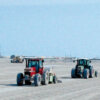Subsea rock installation is a technique used for rock placement to protect marine infrastructure, especially for offshore oil, gas and wind energy projects.
Two types of subsea rock installation can be distinguished:
- One is for shallow water and is typically used for coastal and embankment protection works and for scour protection for the offshore oil, gas and wind energy developments at up to 50 metres of water depths.
- The other is rock installation at greater water depths, usually ranging from 50 to 2,200 metres, and is most frequently applied for the offshore oil and gas industry.
Rock installation at shallow water
For the first, a technique known as “side-stone dumping” is utilised. These are vessels, usually self-propelled, with reinforced, strengthened flat decks upon which rock is loaded. When the vessel reaches its destination, hydraulically or mechanically operated “shovels” known as dozer blades are used to push the rock over the side of the vessel. A series of anchors and winches ensure that the rock is accurately positioned. Side stone dumping vessels (SSDVs) are typically used to install scour protection for offshore wind turbines and offshore rigs, to construct breakwaters and to install rock for subsea pipeline protection.
Rock installation at greater water depths
For very deep water installations ranging to thousands of metres, Dynamically Positioned Flexible Fall Pipe Vessels (DP FFPV) have been developed. Fall pipe vessels are primarily used for the offshore oil and gas industries, for covering pipelines and cables, levelling the seabed or applying scour protection. Sometimes a remote operated vehicle (ROV) is attached at the lower end of the fall pipe for better positioning.
Ultimately the installation of rock at whatever depth is to protect the pipeline or cable or foundation against damage from currents and other natural movement by ensuring that the offshore structure is safely and firmly installed at its location regardless of the natural coastal dynamics on the seabed.






